The Teddy Boy Blues Just Don't Stop
Oh, sure, you know Teddy Boy Blues in the arcades. But that was just the beginning for Teddy Boy. Before you know it, he’ll be traveling around the world and across platforms– and as we’ll see, he won’t be taking Yohko Ishino with him. Where will Teddy Boy go? Why would you trust him to launch your new console? Just how many soundtracks does one game need?
Teddy Boy Blues
1985’s System 1 arcade adaptation of Pitfall II got its first console port to the SG-1000. 1986’s System 1/2 game Wonder Boy also got its first console port to the SG-1000, despite being a game which heavily depended on scrolling, something the SG-1000 couldn’t do without a lot of programmer intervention. (Flicky has smooth horizontal scrolling. Wonder Boy does not.) Hey, Sega had an install base to please!

But that install base wasn’t ready for Teddy. Teddy Boy Blues would become a launch title for Sega’s new 1985 console: the powerful Master System. Well, actually, it was the Mark III. It would be one of only two launch titles alongside Hang-On, and even Hang-On would get an SG-1000 port. (Called, logically enough, Hang-On II) Therefore, Teddy Boy Blues was something special: the first Master System exclusive.

That being said, being such an early Master System title comes with two significant downsides.
-
The game predates 1987’s FM Sound Unit add-on for the Mark III. As a game based around a song, it’d be nice to have an FM rendition; unfortunately, Teddy Boy Blues is played on just a single SN76489, a downgrade from the arcade.
-
Just like with My Hero, Teddy Boy Blues was released on the “My Card” format. This meant it was limited to 32kiB of ROM space; to compare, on System 1 it took up about 168kiB.
Of course, being on a My Card doesn’t mean a cartridge release would have gotten more space, as cartridge SG-1000 games like Flicky only got that much space too. But 32kiB went further on the SG-1000 thanks to lighter-weight graphical assets; on the Mark III, these generally required heavy compression. (Note that on the System 1, graphics compression is impossible)
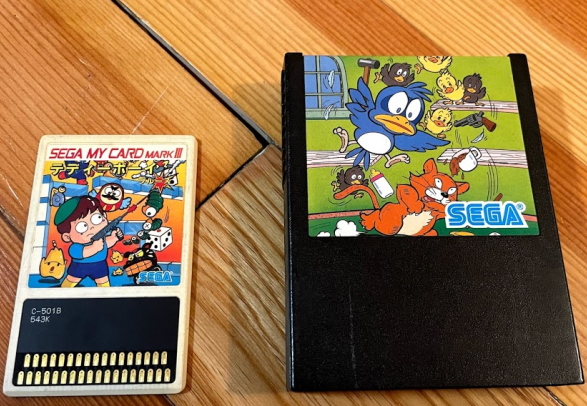
So what did Teddy Boy Blues lose in the transition from arcade to home? Well, we can see above that the title screen is much simpler. Gone is Yohko Ishino and her backup band of game enemies; instead, we just have text, and twice the copyright information. (I find it a bit surprising that no copyright is provided for Teddy Boy Blues the song)
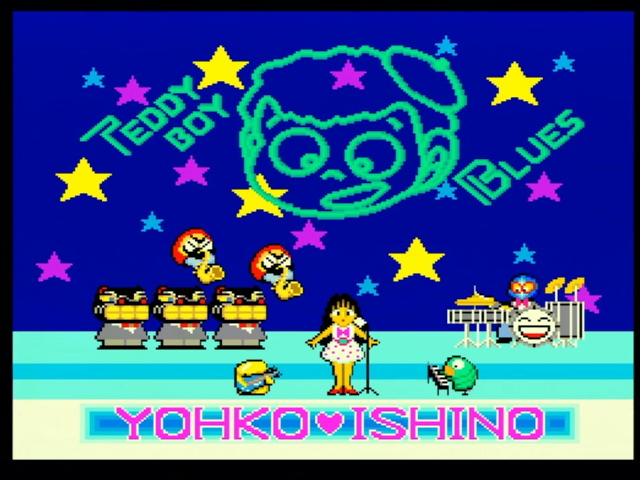
But thankfully, title screens are just cosmetic. The gameplay fares much better.
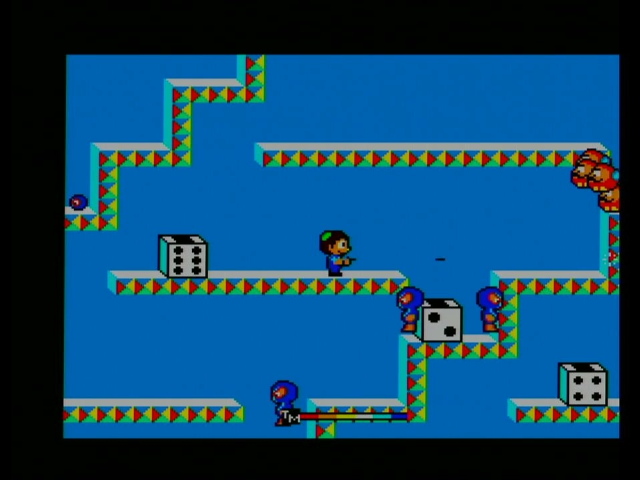

What’s different? The resolution has dropped a bit, a few sprites are less colorful (the Master System offers sprites with 15 colors, but they are from a shared palette), but the game plays just like its arcade counterpart. The only real loss is that your score is no longer visible while you play; this used the System 1’s foreground tilemap, a feature not present on the Master System. (This is also why the timer is a bit smaller, as it’s made of sprites)

The biggest change for the level-to-level gameplay is that score is now totaled up on a separate screen, which puts a little bit more of a gap between levels. But that’s totally acceptable on a home console. It’s quick enough that it’d be acceptable in the arcade, too.

The other big difference is the bonus game. That gave me a lot of trouble in the last post; in this case, both are totally gone, replaced with a single bonus game where Teddy Boy goes across a grid of boxes he can open up; some will have items that give you score, some enemies who will eat your already very meager timer. Levels are not the same as the arcade version, but you can recognize similar themes.
Overall, Teddy Boy Blues holds up very well on its transition to home console hardware; having the fancier Master System certainly helps. So why did Teddy Boy Blues get the Master System treatment when Pitfall II did not? Scrolling, for sure. The game is all about two-dimensional scrolling, and it’s fast-paced enough that the choppy 8-pixel-at-a-time scrolling on the SG-1000’s TMS9918A would just be a nightmare. Don’t get me wrong, it’s an innovative video chip. But it was definitely showing its age in 1985.
No Blues in America
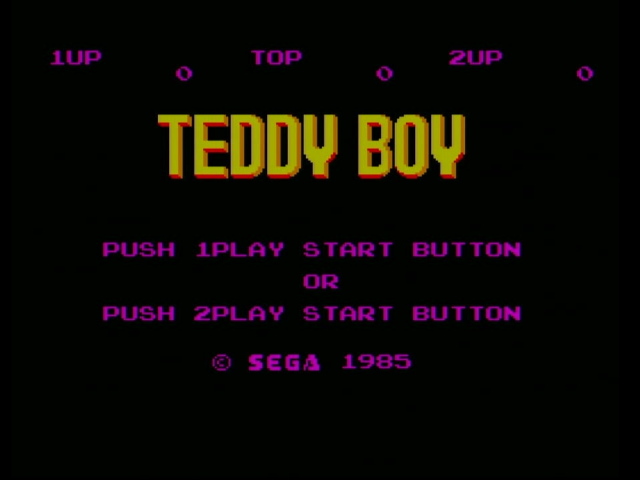
In America and Europe, Teddy Boy Blues became simple Teddy Boy; and as the name implies, it lost the blues. Yohko Ishino’s song is gone entirely, replaced with a more upbeat song in a major key. So it’s a bit more bouncier and more one would expect from a video game; plus, Sega doesn’t have any licensing issues. There’s also a new title screen track, but I’ll just use the gameplay audio here.
In this form, it was eventually released on cartridge (without any changes), and seems to have remained a staple of budget bin Master System titles into the 1990s. In Brazil, meanwhile, Sega license-holder Tec Toy reskinned the game (keeping the international music) with the protagonist from that country’s popular newspaper comic strip Geraldinho. However, they don’t sell it on their modern Master System consoles. (Of course Tectoy sells a version of the Master System in 2022, why wouldn’t they)
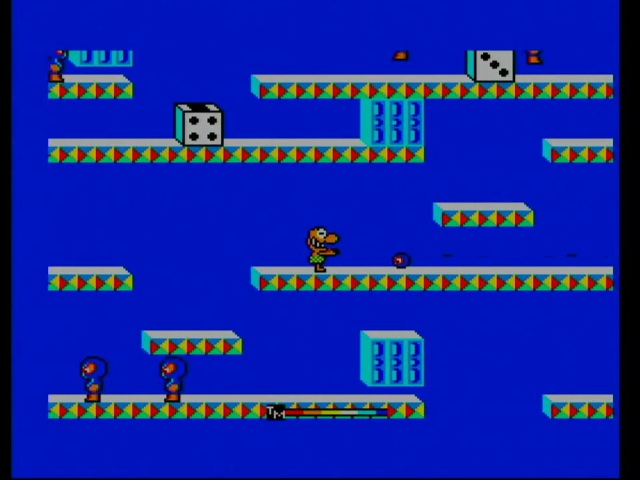
Overall, Teddy Boy Blues, offering a new character and being the system’s only exclusive launch title, seems to have done quite well for itself on the Mark III/Master System. The 1987 game Quartet, originally released as Double Target, featured a hidden level select where protagonist Mary hangs out with other Master System stars: the ship from Fantasy Zone, Alex Kidd, and right there with the rest, Teddy Boy himself. Then again, the protagonist from Pit Pot is there too, and no one remembers that game.

Make the MyCard your own
You might wonder why early Sega seemed so bent on the My Card format. After all, the 32kiB limitation would become particularly problematic as the Master System’s marketing promoted the “Mega Cartridges” (named for their Megabit, or 128kiB of space). An advertising poster apparently included with the Mark III reveals an interesting tidbit:
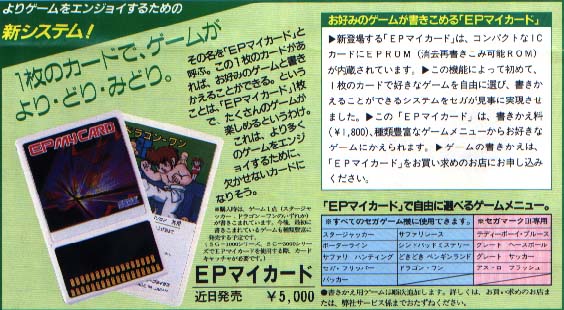
Scan from SMS Power
The EPMyCard, a combination of the My Card with EEPROM memory, that could be reprogrammed at kiosks. This would end up existing for the Famicom Disk System; it’s possible that the Disk System’s pricing is what caused the plan to fall through.
| Nintendo Famicom Disk System | Sega EPMyCard (unreleased) | |
|---|---|---|
| Storage media | Mitsumi “QuickDisk” floppy disks | EEPROM on a card |
| Blank media cost (1986 ¥) | ¥2000 | ¥5000 |
| Rewrite fee (1986 ¥) | ¥500 | ¥1800 |
| Storage size | 2x 64k (double-sided disk) | 32kiB + 40 byte footer |
Sega’s solid state chips would likely be a lot more durable and reliable than floppy disks, but it would likely have been difficult to get these prices down. Whether that was the issue, or something else, the EPMyCard was never released. The last game on the My Card format was 1987’s Woody Pop in Japan, which would never make it out of that country on the Master System, and the 1990 overseas-only hardware revision known as the “Master System 2” in most countries would ditch the card slot entirely.
Why is this relevant? Well, it’s not that relevant. But as far as I know, the only EPMyCard we have is Teddy Boy Blues.

The game is identical to the released Japanese version, with the minor difference in the ROM’s footer, where header information is stored in the export games, and with an additional 40-byte footer containing some bookkeeping information, like the ¥1800 price. A random oddity, but interesting. Having this additional sales channel would definitely have given Sega a strong motivation to fill up a back catalog of Mark III-caliber games that fit into the small footprint.
Mega Time for Teddy Boy
In the rest of the world, as far as I can tell the story ends with the Master System. Teddy Boy didn’t even make it onto the Wii Virtual Console, which only had a limited selected of Master System titles.
But in Japan, Teddy Boy had a bit of a strange time. Our story starts in 1990, with the release of the Mega Modem, a Japan-exclusive add-on that was, as you might expect, a modem. A modem was a device that allowed a computer to communicate with other computers over a phone line using audible frequencies, though the Mega Modem seems to have had a variant which used a serial connection instead. I don’t have either variant.
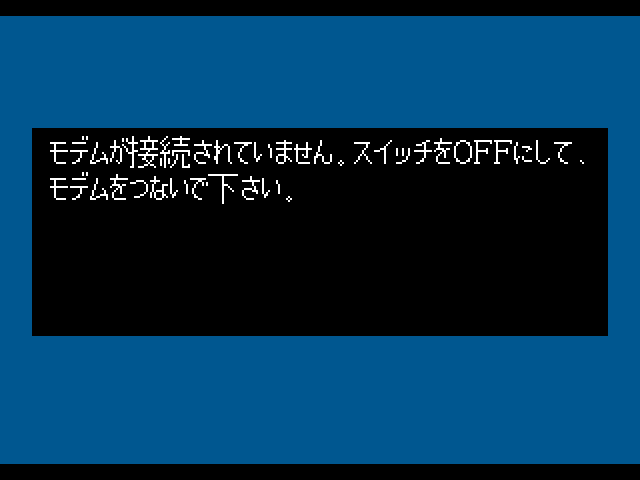
One game that supported the Mega Modem was Sega Game Toshokan. Actually, as the error shows, it requires it. The game allowed people who had a Sega Meganet subscription, which was also required to play multi-player games, to download games over the phone line. Quite an innovative idea for the time, it’s not that different than the modern game subscription services we have today.
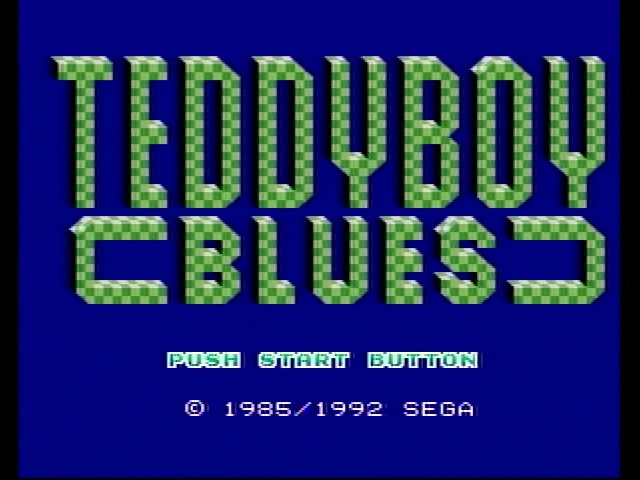
And, in 1992, one of the games that was available for Sega Game Toshokan was a port of Teddy Boy Blues. The Yohko Ishino license at this point being long lost, a new song was needed for the gameplay. Actually, the game was given an entirely new soundtrack, which doesn’t seem to derive from the original or from the international release of Teddy Boy.
However, I’ll play this game using the 1994 CD port, Game no Kanzume Vol. 2. In terms of gameplay it should be a very faithful port. Game no Kanzume was a series of Mega CD game collections that included many of the Sega Game Toshokan titles, notable for coming in a can. (The name means “Game Can”)
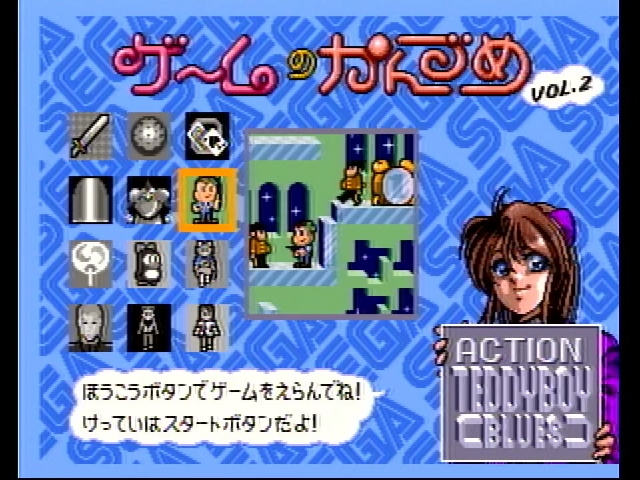
One major feature of the Sega CD is its CD-quality audio. After all, it’s, well, a CD. It can play CD tracks, assuming you’re not accessing the disc for anything else; so for a small game like Teddy Boy Blues, there was no technical barrier to adding higher quality sound. And so, Game no Kanzume has a CD track of the Genesis Teddy Boy Blues music; really a shame the license was lost, this would’ve been a perfect use case to break out Yohko’s original in a way the System 1 couldn’t have.
Teddy Boy Blues, but with more bits
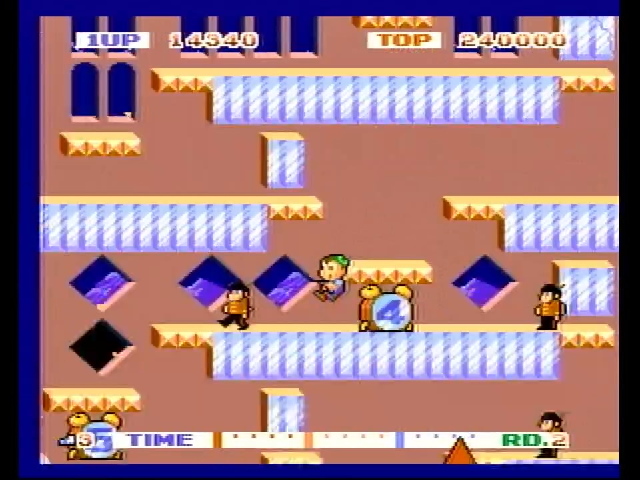
The port of Teddy Boy Blues to Sega Genesis was definitely done with some care. The game now has a story; Yohko Ishino is gone, replaced by a girl “Youko-chan”, being defended by her favorite teddy bear come to life. (Teddy Boy never looked like much of a teddy boy anyway) All of the game’s enemies have been reskinned to fit this theme.

Yet again, the levels are not the same as the arcade version, but there are similar themes. The biggest change to the gameplay comes that enemies no longer spawn from dice. Instead, they spawn from alarm clocks– this does cause a change in strategy, since the alarm clocks take several seconds to ring before they spawn an enemy. This makes it a little easier to tell where your next enemy will come from.
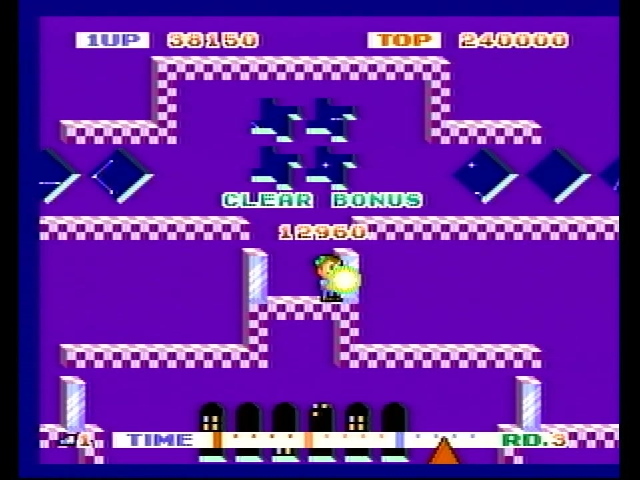
Being on the more advanced Sega Genesis hardware, Teddy Boy Blues now has an end-of-level overlay like the arcade version, and always shows your score on screen along with a larger stage timer. In fact it goes further than the arcade game, with a parallax scrolling background visible through windows in the stage background. The updated graphics look like a logical step forward to me.
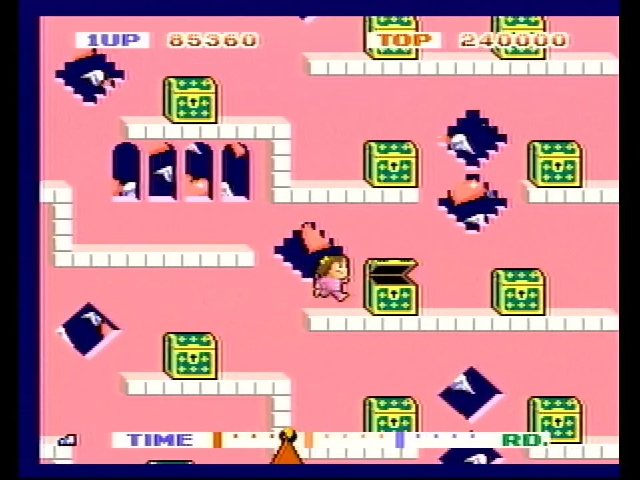
Finally, while they’re less frequent than the arcade or Master System releases, there are bonus levels. They’re like a combination of the Master System bonus level with the Yohko bonus stages from the arcade; you play as Yohko opening boxes to try to find presents that will increase your score, or extra lives inside.
So overall, for a game that never got a chance to stand by itself, the Genesis version of Teddy Boy Blues holds up pretty well. But we’re not done yet!
Sing, but not the blues
I don’t think it’s quite known when in 1992 the Toshokan version of Teddy Boy Blues came out, which is a shame, as we have…

Another release. This CD, SING!! Sega Game Music Presented by B.B. Queens, is presented as a music CD first and foremost. But it’s also a Sega CD game. Well, a Mega CD game– it’s for the Japanese region, as unlike music CDs, the Sega CD is a region-locked system. (And that’s why you’ll have to put up with composite video capture from my Pioneer LaserActive)
Track one of this CD is the game Teddy Boy Blues again, with just one slight difference.
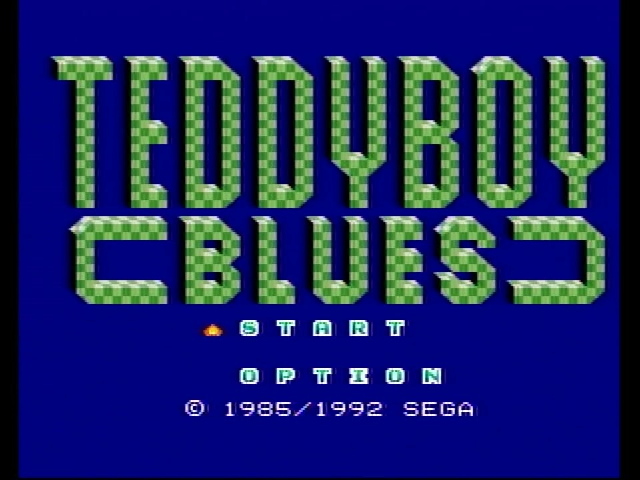
It now features an “option” screen, which allows you to pick from any of the tracks are your background music in-game.

It kind of makes sense that a “game about a song” should work as an add-on to show off some of the game music using a game. The interesting thing is, that track Funky Brothers claims, according to the track listing, to be from Teddy Boy Blues. Let’s give it a listen. Since this is from a music CD, I’ve truncated the song to make sure I’m staying within the realm of fair use; I hope you don’t mind.
It doesn’t sound quite like any of the many Teddy Boy Blues tracks we’ve heard yet. So, what’s the deal? Is it just a particularly divergent rendition of the Genesis version? For a long time, that was the best guess anyone had. But it turns out, no! It’s actually a remix of a track from a game called SegaSonic Bros..
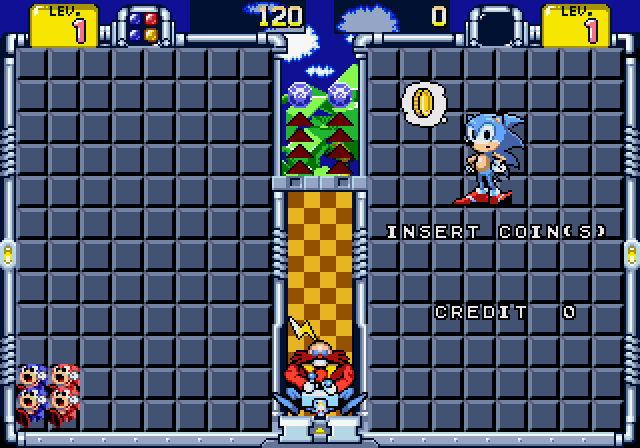
SegaSonic Bros. is a falling block puzzle arcade game that was due to be released in 1992, the same year as SING!!, but it failed its location tests and was shelved. However, it was pretty much entirely complete and recently, images of the game’s ROMs have been leaked and it can be played in MAME. And how does its first level track sound?
That sounds a lot more like Funky Brothers to my ears. It definitely makes me wonder if the hot new Sonic title was considered for inclusion on SING!!, only to get cancelled at the last minute, requiring the album to instead claim Funky Brothers was a Teddy Boy Blues song. Of course, unless someone from Sega or B.B. Queens lets us know, we won’t know for sure.
Teddy Boy, What a Mess
No more releases of Teddy Boy have occurred. While the Sega Game Toshokan version of Flicky got a boxed release in the West, Teddy Boy Blues remained a Japan-exclusive. Who knows why; perhaps it was the fact that Master System versions of Teddy Boy were still available in the discount bins, while Flicky only had the much more limited SG-1000 release. More recently, Game no Kanzume did make an appearance on the Japan-region Mega Drive Mini with Teddy Boy Blues in tow.
Overall, it shouldn’t be that surprising. Teddy Boy Blues is a fun game, but it never seems to have had much cultural notoriety. Later idol games, like PC Engine-CD launch title No-Ri-Ko, would focus much more on growing the relationship between the idol and her fans. But it’s definitely a fun little game, in any of its forms. I’m just not sure it needed so many soundtracks!

A series on: The Teddy Boy Blues
It's a song, it's a game, it's a lifestyle! Well maybe not that last one.
- The Power of Cross-Marketing: Teddy Boy Blues — Teddy Boy Blues the song and the 1985 Sega System 1 arcade release.
- The Teddy Boy Blues Just Don't Stop — Yohko Ishino is left behind as her song becomes a game that's ported to the Master System and the Sega Genesis (and even makes its way onto the Sega CD twice).
